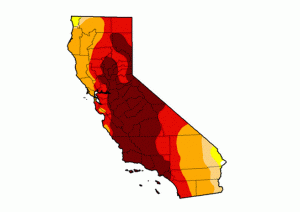CA drought spurs painful rate hikes
 Faced with a drought that won’t quit, officials have taken new steps to add to Californians’ discomfort — a fresh round of rate hikes. Regulators in the San Francisco Bay Area have begun the march toward charging significantly more for water, pleading that limited rainfall this spring has left them with no choice.
Faced with a drought that won’t quit, officials have taken new steps to add to Californians’ discomfort — a fresh round of rate hikes. Regulators in the San Francisco Bay Area have begun the march toward charging significantly more for water, pleading that limited rainfall this spring has left them with no choice.
As CBS San Francisco observed, the plans taking shape within three of the state’s largest water agencies reflect a cost crunch impacting the Santa Clara Valley Water District and the San Francisco and East Bay Municipal Utilities District.
The agencies have found themselves between a rock and a hard place this year, reluctant to put the squeeze on already restive residents, but strapped with mounting costs set to increase even further.
As Beau Goldie, CEO of the Santa Clara Valley Water District, bluntly told the San Jose Mercury News, “We don’t want to raise water rates.” But Goldie and other district chiefs have targeted hikes of 30 percent or more because water conservation has slashed sales. As the Mercury News reported:
“Because they have sold less water, the agencies have lost tens millions of dollars in revenues. They also have had to spend more money on drought-related expenses such as buying extra water from outside the Bay Area to help meet demand, expanding public relations budgets to ask the public to use less water amid shortages, and offering rebates to homeowners who replace lawns with drought-tolerant plants or old, leaky appliances with water-efficient ones.”
Groundwater bank
Santa Clara Valley has been reduced to shelling out millions of dollars to pump in water from a so-called “groundwater bank” located in Kern County. EBMUD, falling back on the same strategy, has put its hopes in using its share of limited drought relief funds to bankroll imports of its own, spokeswoman Abby Figueroa told KTVU Fox Channel 2 News. “We will have to continue asking our customers to cut back their usage,” she added. “How much is still being determined.”
According to KTVU, EBMUD saw customers conserve last year at a rate 13 percent higher than two years ago. But this year, residents seemed close to maxing out their ability to cut back. So far, the savings rate has dropped to just 4 percent.
Still, the size of the dropoff had EMMUD contemplating an increase in its current voluntary conservation rate to 15 percent, ABC 7 reported. Voluntary conservation could even be replaced with mandatory conservation.
Spreading confusion
At the same time as the utilities have sorted through unattractive options, water management outside the San Francisco Bay has also been hit with confusion and frustration. Because of the complexity created by the Golden State’s separate state and federal water programs, Kern County will receive more water than communities and farms on the Eastern and Western sides of the San Joaquin Valley.
As the Fresno Bee reported, while the State Water Project has supplied Kern, the federal government’s Central Valley Project has kept water flowing to those in the East and West of the Valley — that is, when there is water.
Though similar in size and infrastructure, the federal and state projects’ differences have created “a complex and uncomfortable flashpoint in the Valley,” according to the Bee. It added:
“For one thing, the smaller state project has a somewhat lighter burden, because it does not have to provide more than 300,000 acre-feet of water for wildlife refuges as the CVP does.
“The subtle difference is a big deal in a drought, when there is so little water to go around. Other below-the-radar differences, such as water-delivery pecking order dating to the 1800s, are magnified in a drought. Those with historic rights get their water first.”
With challenges radiating outward from San Francisco Bay into the Central Valley, utilities chiefs along the Central Coast and in Southern California soon could have reason to fret.
Related Articles
Goal of online tobacco sales ban: more state tax revenue
California may be considered a technology pioneer, but at least one state lawmaker wants to put the brakes on a
State finds savings in minimum wage increase, but counties get the bill
The good news: Last year’s deal to increase the minimum wage won’t cost the state nearly as much as was projected.
Mixed reviews for Gov. Brown on actor age database law
Rarely the subject of entertainment industry buzz, Gov. Jerry Brown sparked outrage and confusion among First Amendment advocates by a new




